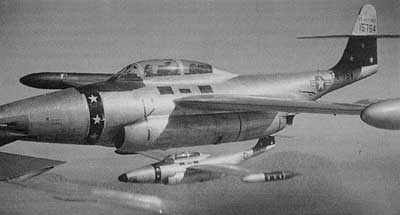The
"Kinross Case", so called for the name of the
air force base (AFB) from which the plane departed, involves
the disappearance of a fighter jet and its crew, pilot
Felix Moncla and radar observer Robert Wilson, sent to
investigate an unknown object that was tracked on radar.

This
is a photograph of a F-89 Scorpion fighter jet.
The
history of the Kinross Case began on November 23, 1953.
A US Air Force F-89 jet fighter was scrambled from the
Kinross AFB in Michigan. The plane known as the Scorpion
was sent on an "active air defense mission"
to intercept an "unknown object." Speculation
as to the identity of the object has been the subject
of debate for over 50 years.
American
officials claim that the object was simply a Canadian
aircraft, while Canadian officials deny the claim, citing
that there were no Canadian aircraft in the vicinity at
the time of the incident.
The
following is extracted from the official accident report:
Aircraft
took off at 2322 Zebra 23 Nov 53 on an active Air Defense
Mission to intercept an unknown aircraft approximately
160 miles Northwest of Kinross Air Force Base. The aircraft
was under radar control throughout the interception. At
approximately 2352 Zebra, the last radio contact was made
by the radar station controlling the interception. At
approximately 2355 Zebra, the unknown aircraft and the
F-89 merged together on the radar scope. Shortly thereafter,
the IFF signal disappeared from the radar scope. No further
contact was established with the F-89. (The next 16 or
so letters as well as the entire next sentence have been
blacked out by Air Force censors) An extensive aerial
search has revealed no trace of the aircraft. The aircraft
and its crew are still missing.
Radar
operators claim that the F-89 and the unknown object seemed
to merge on their radar screens. At about the same time
as the "blips" seemed to collide, both voice
and identification friend or foe (IFF) contact were lost.
According to reports, after the two objects came together,
only one object, the original rogue object remained and
it appeared not be affected as it continued on its original
course and speed.
A
large scale search was immediately launched. It's important
to note that the aircraft was lost in late November and
although the weather was stable, it was winter, snow covered
the ground and the water of Lake Superior was freezing.
Sources:
http://en.wikipedia.org/wiki/Felix_Moncla
http://listverse.com/2011/03/14/top-10-people-who-vanished-in-airplanes/
http://www.ufobc.ca/kinross/
